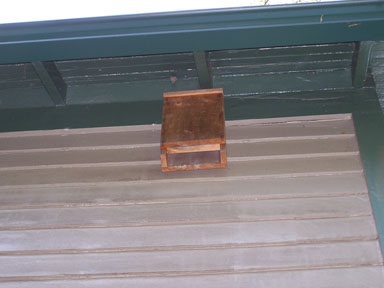September 1, 2010
Senator Gillibrand to visit Dryden Thursday
Senator Kirsten Gillibrand will be kicking off her statewide agricultural listening tour this Thursday in Dryden, at 1:00pm at the Jerry Dell Farm, 276 Simms Hill Road.
Tonight, there's a forum for Sheriff candidates Peter Meskill and Ken Lansing, who will face each other in the Democratic primary September 14th and in November. There's also a piece on their thoughts on how better to control crime.
Most of Dryden's children who live in the Ithaca City School District go to Caroline Elementary School, which has a new principal this year.
Counting traffic
I just posted on the New York State traffic count map, and then I looked down the road to see a traffic counter. There's not a whole lot to it, but this is how those numbers get created.
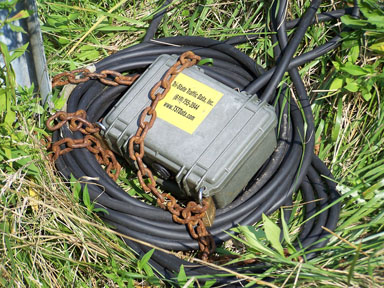
The brains (really memory) of the traffic-counting operation.
Bats in the bat house
I really hate mosquitos, and news that bats are in severe decline because of white-nose fungus worries me:
populations of little brown myotis in the 115 hibernation locations the study covered were falling at rates ranging from 33 percent to 99 percent per year, with an average decline for the Northeast of 73 percent each year.
Slightly more than 1 million bats have vanished in the past two years, the team estimates. The team calculates that out of an initial population of some 6.5 million bats, the little-brown-myotis population could fall as low as 65,000 by 2026.
... given the bats' rate of bug consumption, the casualties so far would have consumed about 694 tons of insects in one warm season.
For now, though, I have bats, as this mess indicates:
The bathouse faces south, tucked under the roof of the house in a spot where there isn't a nearby window.
The fungus disease seems to afflict bats when they hibernate in large groups in caves, so I doubt my bat house will make a big difference that way. For now, though, I'm just happy someone's there.
History of a Property
While cleaning out piles of paper that used to live in my office a few weeks ago, I found the abstract of title for my house. It's a history of transactions for the property, going back to 1900 with a brief stop in 1875. I won't repeat all of it here - lots of it is legalese and contracts - but there are interesting pieces throughout.
- November 18, 1875
Mortgage to secure $1000, by Mary E. McKinney and J.M. McKinney, her husband, conveys "the farm and premises which Casper Miller died seized and upon which he resided at the time of his death supposed to contain about one hundred acres of land". Mortgage conveyed to S.B. Korts in 1889.
- March 21, 1900
Referee Edward N. Jackson to Stephen B. Korts, $900 highest bid. Conveys "that part of the Casper Miller farm heretofore owned by Mary E. McKinney and Anna D. McDonald jointly.... bounded...on the north by the lands now or formerly owned by Ira Snyder, Jane Snyder, Peter Snyder, and by one Hallett; on the east by lands of the said Peter Snyder to Fall Creek; thence along the center of Fall Creek to the Mill property known as the Sherwood Mill property, later owned by John Perrigo; thence on the west by... Henry J. Freese... Also all that other tract or parcel of land bounded on the north by the Elmira, Cortland & Northern Railroad... Mott J. Robertson... Walter Snyder... Hiram E. Talmadge..."
You can find at least some of these names in this map from the Goodrich Centennial History of Dryden:
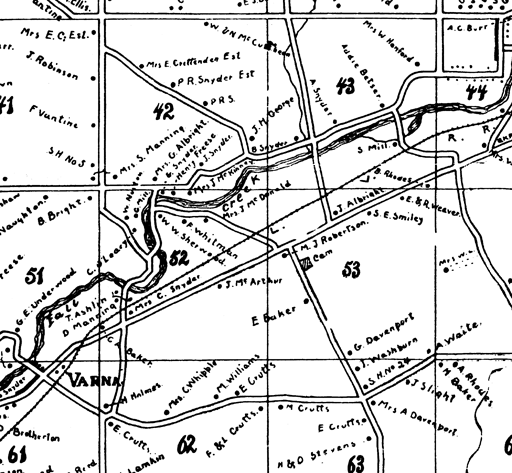
West of Varna, 1898. (Click to enlarge).Mrs. J. McKinney is on the opposite side of Fall Creek, but M.J. Robertson is obvious, right next to the cemetery area. I'm guessing the S. Mill with millpond by the railroad near the creek is the Sherwood Mill. (Robertson's house is now the Plantation, I believe, and I'm a few doors west of there.)
- April 8, 1903
Stephen B. Korts and Kate L. Korts, his wife, to Caroline Snyder. "Estimated to contain twenty acres of land more or less."
- November 24, 1915
Caroline Snyder died intestate (no will) August 11, 1914, alleged will destroyed. One-third interest to her attorney, Charles H. Blood.
- 1915-1919
Five transactions between Blanche Snyder Lee and Charles H. Blood that eventually leave it with Charles H. Blood.
- May 8, 1919
Charles H. Blood to John Edward Watkins, for $1.00 etc, though subject to prior lease and $1900 mortgage Charles H. Blood gave Watkins on May 7, 1919.
- July 3, 1922
John Edward Watkins and Bertha Watkins take a $3000 mortgage from Jesse E. Whipple.
- September 20, 1928
John Edward Watkins to John Edward Watkins and Bertha I. Watkins, husband and wife, as tenants by the entirety for $1.00 etc. - though "excepting and reserving from this conveyance the properties deeded prior to this deed and the rights of Ray Evans and Emery Baker under executory contracts for land heretofore sold to them by contract; the deeds to be given later."
- August 13, 1929
The Watkins grant NYSEG a right-of-way along Dryden Road.
- September 7, 1929
The Watkins give the deeds to Emery F. Baker and Hettie Baker. Contracted in 1923, for $1.00 etc.
- June 27, 1929
Emery F. Baker and Hettie Baker grant NYSEG a 100-foot right of way further up the hill.
- September 10, 1930
Emery F. Baker and Hettie Baker to Arthur Prince, subdivision of lots by the road. This is for the land just east of mine - 16 rods (16.5' in a rod) and 8.5' from Bridle Road to iron stake. "Party of second part agrees to build and maintain at his own cost and proper expense a fence to hold cattle along the southerly line of land herein conveyed to said second party and the parties of the first part reserve the right to removed the wire fencing along said highway."
- September 10, 1930
Emery F. Baker and Hettie Baker to Lester Eugene Baker for $1.00 etc. - east from Prince lands, 8 rods frontage, 16 rods 8.5' deep. This is my parcel as it is today.
- September 30, 1930
Lester Eugene Baker grants NYSEG a right-of-way along the highway.
- May 13, 1932
Lester Eugene Baker adds Thelma Baker, his wife, to the title, "survivor to take the whole."
- June 14, 1932
The Bakers take a mortgage for $1319 from Lester J. Lidell.
- May 23, 1945
The Bakers sell to Lawrence J. Sickmon and Julia M. Sickmon for $4000.
- June 15, 1945
The Sickmons take a mortgage for $2700 from Tompkins County Trust Company.
- February 8, 1949
The Sickmons take a mortgage for $1120 for Tompkins County Trust Company.
- June 4, 1968
Julia M. Sickmon sells to Ronald L. Volbrecht for $1.00 etc, but Volbrecht also takes a "purchase money mortgage" from Ithaca Savings Bank for $9,675.
- March 16, 1976
Ronald L. Volbrecht sells to Marguerite Y. Williams for $1.00, and she takes a mortgage out for $19,600 from Citizens Savings Bank. This one has a map!

Along Dryden Road, 1976. (Click to enlarge).The map looks like an edited version of an older 1959 map, since Route 13 had become Route 366 by then. It tells me, though, that the house number used to be 1178, and that Lloyd Bell, who I'd heard might have built this house, owned the very similar house at 1243 Dryden Road.
- November 19, 1999
Tracey Cranston and I buy the house from Marguerite Y. Williams for $63,500. I become sole owner on November 16, 2005.
My understanding (and that of the Tompkins County Assessment Department) has been that the house was built in 1929. I wonder if 1930 is more likely, given the subdivision in September 1930, but maybe they built the house before the subdivision happened.
Most of the time, people think of history as stories of people. Every now and then it's nice to take a step back and look at how something passed through the hands of many people.
September 2, 2010
Varna II application bounces
Last we'd officially heard, there'd be news about Steve Lucente's proposed Varna II (or whatever he'll call it) project in "two to three weeks". That was about six weeks ago.
I hadn't seen anything new from Lucente, but apparently he submitted an application that didn't get far enough to be officially accepted. I wrote the Zoning department to ask what was up, and Kevin Ezell replied:
The application was rejected because there was no vehicle that the Town has to review it. This is according to Henry M. Slater. The application is not in the office and therefore is not available for review. The application would be part of the public record and you would be able to inspect it when we have accepted the application.
I doubt this is more than a bump in the road - presumably they'll modify the application so it can be accepted.
The "no vehicle...to review" makes me wonder if they structured it in some way that doesn't exist under current zoning, but I'm not really sure how to interpret that. I wonder if it may be something the new zoning will address, or if it's something they can work around under the current zoning that allows them more units.
I also wondered if they were still pushing for denser zoning than I suspect is legal, but the evaluation doesn't seem to have gone that far.
I'm sure they'll be back.
September 3, 2010
Senator Gillibrand holds agriculture conversation
Senator Kirsten Gillibrand visited Jerry Dell Farm yesterday, looking for input on the 2012 farm bill. The crowd had lots of suggestions, from biofuels beyond ethanol to clearer and better-financed farmland protection to making the market for milk make some kind of sense.
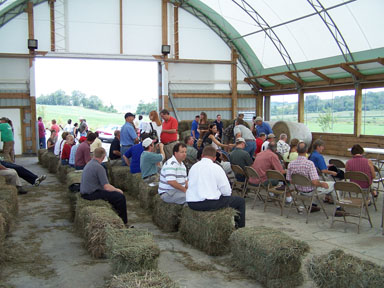
Crowd gathers at Jerry Dell Farm.
The Journal reports on the event, but there are a couple of pieces I'd like to highlight. I was pleased that she took the "listening" part seriously, with only a very brief opening statement and extended back and forth with the people talking. She also encouraged follow ups from other people in the audience, which made for a much more coherent conversation than the usual random sequence of statements.
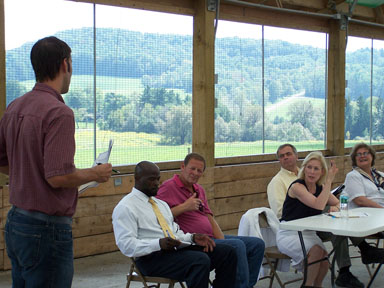
Dryden Environmental Planner Dan Kawsnowski asks Senator Gillibrand about farmland protection.
She was also pleasantly blunt about some key issues, calling it "pretty outrageous" that imports don't have to meet the same standards as food produced in the U.S., and said she'd "work to level those requirements" in the farm bill. I was also impressed that she described agriculture as a national security issue, and not just in a U.S. vs. the rest of the world way - she was concerned that we need to avoid concentrating everything in a few regions, and make sure that farms in the northeast and southeast continue to operate despite the scale advantages of the midwest and west.
The only thing she said that I disagreed with was that we can't get farmland back once it's been developed. True, we can't easily get it back as traditional open farmland for extensive agriculture, but there are still opportunities there for intensive agriculture at least some of the time. I'll write more about that soon.
I've posted a gallery of photos of the conversation.
Journal posts local salaries
I'd complained earlier that the salary averages the Ithaca Journal posted were weirdly meaningless, but today they've posted lists of salaries.
It's oddly incomplete, with only some municipalities included, but the Town of Dryden, Village of Dryden, and Tompkins County are there. Freeville is missing.
September 4, 2010
County budget forum bleak
All three of Dryden's county legislators - Martha Robertson, Mike Lane, and Brian Robison - came to the Dryden Community Center Cafe with County Administrator Joe Mareane to talk about the county budget Thursday night. The crowd filled the cafe and kept growing over the course of the evening, and I was impressed that very few people left early.
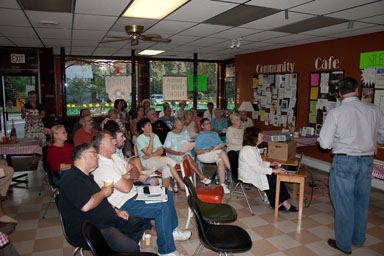
Filling the Cafe for a budget talk.
While town government has a lot of flexibility in what it can offer, county government seems to be about two-thirds an outpost of state government, with very little choice in what it can do. At the same time, many of the services we think of as core county services - road maintenance, sheriffs' road patrols, the library - are among the few things the county actually has the power to cut. (The county's assembled a complete list of programs (1.3 MB PDF), if you want to take a look.)
This year, the outlook is, well, awful. Pension costs, set by the state and largely driven by the falling financial markets, are skyrocketing. Unemployment for the county, though lower than many other places in the state, has climbed from 3.8% in June 2007 to 6.1% in June 2010. Food stamp cases have climbed 39% in the last two years. Healthcare costs continue to climb, though the formation of a countywide consortium will ease that slightly. Sales tax income is holding reasonably steady, but the total value of assessed property is slightly down.
Dealing with this is also complicated by the entanglement with the state. Mareane cited one case where the county might save some money - but at 35 cents on the dollar of services cut, because of state reimbursements. (Oh, and those reimbursements are often late.)
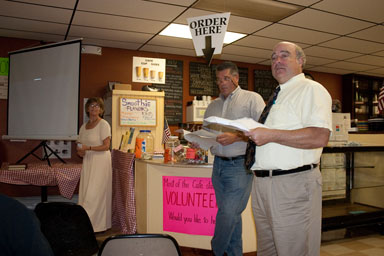
County legislators Martha Robertson, Brian Robison, and Mike Lane.
I think Dryden Daily KAZ sums up the politics of the conversation pretty well. There was a crowd of people there to push for youth programs, especially programs supported by the Dryden and Groton Youth Commissions, and there was a different crowd there to push against government generally, taxes in particular.
Legislators clearly have a difficult job ahead of them.
livingindryden.com
I originally registered this site as livingindryden.org, because I wanted to make clear it was a non-commercial site and I had dreams of maybe other people joining the fun. That's caused a lot of confusion over the years, though, as someone registered livingindryden.com and parked it as an advertising site. Lots of people assume .com as the default, so figured my site had disappeared.
As of today, though, I've bought that registration (for a reasonable $29 at that - patience pays), and you can visit the site at livingindryden.com as well as livingindryden.org.
September 7, 2010
Campbell Meadow
I'd heard about Campbell Meadow for a while, but didn't get to visit it until this morning, when it really sparkled.
The Town acquired this property at the corner of Lower Creek and Pinckney roads years ago. There were some excellent - mostly flat and clear - winding trails through the meadow and along Fall Creek. The creek access isn't ideal, and Sungiva and I skipped trying to go down the steep slopes, but it still made for a beautiful walk and would be an excellent place for a picnic or birdwatching.

Fall Creek from Campbell Meadow.

Lawn near the edge of Fall Creek.
I've also posted a gallery of many more photos of the area.
September 8, 2010
Drying foods and making tomato paste
The Dryden Preservation Corps will be meeting tonight at the Dryden Community Center Cafe at 6:30pm, and again next Monday. They'll be putting the kitchen to different use, preserving foods and teaching preservation:
- September 8th Wednesday, 6:30-8:30 pm
DRYING AND DEHYDRATING FOODS Kerra Quinn will lead us. Kerra will be demonstrating various foods and the techniques required for preserving by drying. Kerra will bring examples of dried foods, explain how foods need to be prepared for drying, demonstrate drying methods and equipment, and give us tips she has learned through the years. PLUS you will go home with a sample of dried vegetables to make a serving of soup! All you need to do is bring a ziploc bag to take your sample home in.
- September 13th Monday, 6:30 pm
TOMATO SAUCE Marie McCrae will be leading us again. Bring a quart jar and a ring. Lids will be provided. Marie will explain how to prepare the tomatoes and cook down the sauce, and then we will work with sauce she has already cooked down.
They're also looking for people to teach applesauce, fruit leather, pickling, root cellaring, and overwinter storages. If you're willing to teach or know someone who does, leave a comment here and I'll see that it gets to Anne Rhodes.
Jazz meets Indian Classical; county budget bleak
Cathy Wakeman's Dryden Town Talk column discusses a free concert coming up September 16th at Dryden High School that will mix contemporary jazz with Indian classical music.
She also notes the Dryden Historical Society's September 15th event on the Dryden Mutual Insurance Company's 150th anniversary and the book of Verne Morton photographs they've commissioned in celebration. The Ellis Hollow Community Fair will be this Saturday from noon to 5:00pm, and the Finger Lakes Land Trust will celebrate its acquisition of 39 acres from 5:00pm to 7:00pm on September 16th at the Ellis Hollow Community Center.
TC3 will be holding a celebration of the life of former professor Ted Szymanski on September 17th at noon. I posted about a remembrance of Szymanski at the Varna Volunteer Fire Company earlier.
The county administrator released a draft budget, which lives up to the dark billing last week's budget presentation suggested. Total spending is flat, though the local share of spending climbs 0.6%. Sales taxes have been stable, but property taxes will climb 5%:
A 2011 proposal presented Tuesday to the Tompkins County Legislature included elimination of some child welfare and youth programs, reduction of the county's alternative-to-incarceration day reporting program and the elimination of a whole road crew from the Highway Department.
Programs slated to be eliminated from the county's budget include the Certified Home Health Agency in the health department, the Municipal Youth Development program, which distributes funds to municipalities to support afterschool youth programs, and the Learning Web Community and Career Apprenticeship program, which offers academic help and job training to youth.
An article on the impact of the jail on the Sheriff's race notes the possibility of a joint Tompkins-Cortland jail. I don't think getting there would be easy, but it's something to contemplate.
Town Board starts exploring zoning
As they'd said they would, the Dryden Town Board took on the proposed local zoning law tonight. I'd misheard Supervisor Mary Ann Sumner's homework assignment - she didn't want to discuss setbacks tonight, but wanted to make sure board members had read the law up through setbacks to be ready to discuss the opening sections of the zoning.
I didn't hear any diabolical attempts to take away people's freedom tonight, or any rhetoric like what I'd seen at the informational meeting. The only other person from the public there was from the Ithaca Journal, and while I was very glad to see them there, this wasn't a meeting that really leant itself to exciting story-telling.
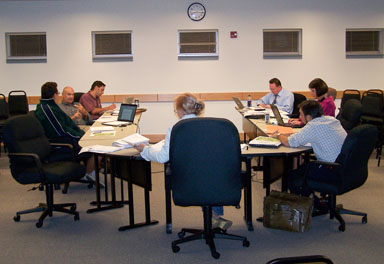
Town Attorney Mahlon Perkins talks about differences between local laws and ordinances with Dryden Town Board.
That is, unfortunately, kind of a problem. The board seems to be starting at the beginning of the law and working their way through to the end (though Attorney Perkins noted that the last thirty pages or so was existing law that didn't need repetition.) They did some good work in the definitions section, clarifying some definitions and hopefully reducing the pile of R-rated adult zoning definitions that aren't actually referenced elsewhere in the law. I think they got as far as building height before jumping out of the definitions section to areas that actually begin to apply those definitions.
The problem, as I see it, develops in two ways:
First, the proposed zoning law scatters bits and pieces of information around. The use table is great for figuring out at a glance what's allowed in a variety of zones, but there is no place in the document that brings together a description of the main zones with what uses are allowed them and features like the density and bulk tables. Figuring out the commercial (CC) zone means reading a definition on page 20, exploring the table on pages 22-26, following a column down page 27, and marveling at the density table on page 32. There's no single place that actually tells you what a commercial zone should be, and as Attorney Perkins put it, "I'm totally confused by this definition." (The overlay zones are better clustered and easier to understand.)
Second, editing the law section by section pretty much ensures that the conversation will follow the shape of the existing law, without much opportunity to step back and ask "is this what we really want?" There was a bit of discussion about a possible neighborhood residential zone that Environmental Planner Dan Kwasnowski had suggested, but breaking a new zone into the current document and conversation structure looks likely to be a challenge.
Yes, I'm picking on the commercial (CC) zone. Although a lot of people have expressed concerns about the conservation (CV) zone's impact, the CC zone is pretty much where the various competing elements of the zoning snarl together. It's a commercial zone that's also a dense residential zone when water and sewer are available. While this zoning is supposed to combat sprawl, the CC zone offers many opportunities to scatter it across and around the Town, mostly along already busy roads. As Perkins noted, it does some odd things like ban Bed-and-Breakfasts while allowing hotels and motels. Unfortunately, that tangled mess seems likely to be about our only option for shopping in the Town if it passes. (Okay, the hamlet zone will allow shopping and is almost as tangled, but at least folks in Varna got the Town to contemplate changing it.)
So what's to come? Dan Kwasnowski laid out a list of areas that need discussion:
Varna. This conversation is getting started back at the Planning Board, and Kwasnowski thought the plan put forward by the community should provide a workable start for addressing this quickly.
Large Scale Retail. There's an overlay district designed to allow this, but it's not on the map. Should it be? Should it be left off? Deleted entirely?
Site Plan Review and Special Use Permits. It sounds like informal opinion leads to the Planning Board handling projects that are just Site Plan Review and the Town Board handling anything that needs a Special Use Permit.
Density Tables. Pages 27, 31, and 32 have their controversial moments.
Overall organization. Some of this is the question of a local law as opposed to an ordinance, and the Town is leaning toward a local law. There's also content in here that duplicates material in other laws, and doesn't need repetition.
Use table. Apart from the details of what's allowed where, are pages 22-26 the best way to present the information?
Map. The map is always critical, usually the first thing readers turn to.
Some new concepts. Kwasnowski cited the frontage density formula as something he'd expected to hear more about but hadn't, and took the silence as a possible sign people don't understand it.
I also raised the question of accessory uses - some clarifying language would ease my concerns about accessory uses. The current draft isn't explicit enough about allowed secondary uses while being very explicit about prohibited uses that happen to be prohibitions only on primary uses.
September 9, 2010
Comparing existing zoning to proposed - setbacks
One of the less noted but still important changes in the new draft zoning law is changes in setback distances. The Area and Bulk Table in §600 lays out setbacks that are either smaller or the same as the existing zoning requires.
As before, the old zoning districts don't correspond neatly with the new. To figure out what's changing for a specific area, you need to visit the old map (image or PDF), and figure out what zone the parcel is in. Then you need to visit the new map (image or PDF) to see where it's going.
Key:
- RR
- New Rural Residential
- RA
- New Rural Agricultural
- CV
- New Conservation
- H
- New Hamlet
- CC
- New Commercial
- LIO
- New Light Industrial/Office (LIO-A adds Adult)
- RB, R-B-1, R-C, R-D
- Existing zoning codes with residential base
- M-A
- Existing Manufacturing zone (M-AA adds Adult)
| NEW (July 2010) DRAFT ZONING | EXISTING ZONING | |||||||
|---|---|---|---|---|---|---|---|---|
| USES | RR, RA, CV | H | CC | LIO | R-B, R-B-1, R-C | R-D | M-A | |
| Minimum Front Yard Setback | 50' | 10' | 40' | 40' | 70' | 70' (90' on state highways) | 90' | |
| Minimum Side Yard Setback | 15' | 0' (attached buildings) 7.5' (not attached) | 0' (attached buildings) 7.5' (not attached) | 15' | 15' | 15' | 15' | |
| Minimum Side Yard Setback for accessory building < 15' high, 200 sq. ft. | 1' | 1' | 1' | 1' | 15' | 15' | 15' | |
| Minimum Rear Yard Setback | 25' | 25' | 25' | 25' | 25' | 25' | 15' | |
| Minimum Rear Yard Setback for accessory building < 15' high, 200 sq. ft. | 1' | 1' | 1' | 1' | 15' | 15' | 15' | |
My guess is that the smaller setbacks for small accessory buildings will spare the Zoning Board of Appeals a lot of variance requests. One foot is a pretty small margin of error, though, so hopefully people will be careful to note where the property lines actually are.
Before you start making plans to put accessory buildings in front of your house, though, you should note that buried in the definition of "Use, Accessory" is a statement that "Unless stated otherwise in this local law, an accessory structure shall not be permitted in the front yard of a principal use."
Dryden Youth Opportunity Fund hosts Fair
The Dryden Youth Opportunity Fund with be sponsoring a Dryden Youth Opportunity Fair Saturday the 11th from 9:00am to noon at the Dryden Fire Hall.
Etna yard sale Saturday
My copy of the Etna Volcano arrived just in time to alert me that the Etna Community Yard Sale is this Saturday from 9:00am through noon at Houtz Hall, 2 Lower Creek Road. They're still taking donations today and tomorrow from 1:30pm to 5:30pm. (No adult clothes, house paint, chemicals refrigerators, firearms, or encyclopedias.)
There's a report on further updates to their excellent playground, information on the Etna Community Church, and news of the following upcoming events:
Soup & Salad Supper- October 20th, 5:30pm-7:00pm
Halloween Party - October 30th
Craft Fair - November 6th
Soup & Salad Supper- November 17th, 5:30pm-7:00pm
September 10, 2010
Journal reports on zoning process
I know I haven't had much kind to say about the Ithaca Journal lately, but Rachel Stern really hits one out of the park with her report on Wednesday's Town Board meeting on zoning. I'd written that:
the only other person from the public there was from the Ithaca Journal, and while I was very glad to see them there, this wasn't a meeting that really leant itself to exciting story-telling.
Fortunately, Stern doesn't focus much on the minutiae of the meeting, except to note some questions about "local law" vs. "ordinance" that give some flavor of what it was like. Instead, she reports on what Town Board members have to say about the process, in interviews I'm guessing she did afterward:
"We want to make sure we find all the details that are wrong," Sumner said. "Even as familiar as we are with it, sometimes it's like, 'Oh dear, we didn't think about that.' It's complicated."
It is her "fantasy," or goal, that the review will be completed and the board is prepared to vote by January....
"We will be done when it's ready," Deputy Supervisor David Makar said. "We want to be thorough because it has a big impact on the town."...
Stelick, who estimated the board got through 20 pages of the document Wednesday night. "But you learn patience because this is going to be local law. This affects a lot of people."
There's a lot more there, as she explains the context, the timing, and some of what got done, but those quotes at least convey a bigger story than editing line by line. The only glitch is that she reports no residents were present, which is sadly almost true. I'm guessing she counted me as "media" rather than "resident". More people really should be at these, even if, as Steve Stelick all too correctly says, "I am in my ninth year [on the Town Board], but earlier on I would have lost consciousness."
The comments about "done when it's ready" make me happy, but I worry - and said I was worried at the end of the meeting - about the focus on details. While the details certainly need polishing, and there's some simple pruning that can make the law more readable, I don't think the law is anywhere near ready for this kind of final polishing. The board seemed Wednesday to accept its task as cleanup, without much response to the pretty ferocious comments they've heard.
The one piece they've (wisely) recognized needs more than polishing is the zoning in Varna, but there are plenty of other large issues in the rest of the document. Hopefully they'll notice them while wordsmithing.
Road closings next week
It'll be a little trickier to get from the Town of Dryden to the Town of Ithaca next week, as Forest Home Drive will be closed Monday and a piece of Snyder Hill Road will be closed Tuesday.
From the Comp Plan to the Draft Zoning
While the zoning process is sort of technically the "implementation of the Comprehensive Plan", there are many changes from the 2005 Comprehensive Plan to the 2010 Draft Zoning. Some of that is to be expected, but I think it's still worth highlighting some of the more dramatic changes. (It does, unfortunately, take a lot words to do that, so the details are in the extended section.)
In some substantial cases, I don't think pointing to the Comprehensive Plan and calling the zoning an implementation still holds.
Summary
The commercial zones are no longer recognizable as anything specified in the Comprehensive Plan. I'm not sure what happened there.
The overlay districts in the zoning are more or less complete innovations.
The residential and hamlet zones in the current draft of zoning don't begin to manage density with the precision suggested by the Comprehensive Plan, but still sort of look kind of like what the Comprehensive Plan said. (Work getting started on the hamlet zone will likely lead toward something more like what the Comprehensive Plan suggested.)
Conservation and agricultural areas are generally more loosely regulated by the draft zoning than the Comprehensive Plan, but follow the same broad outlines.
The light industrial/office proposal has seen very few changes between the two.
Comparing Kinds of Areas Described
The Comprehensive Plan listed 10 land use types, while the Draft zoning has six plus two overlay types. Roughly comparing the two, here's how they break down:
| Draft Zoning | Comprehensive Plan |
|---|---|
| Commercial (CC) | Retail Commercial |
| Route 13 Highway Corridor Overlay | |
| Rural Residential (RR) | Rural Residential |
| Suburban Residential | |
| Hamlet (H) | Hamlet |
| Conservation (CV) | Conservation/Open Space |
| Rural Agriculture (RA) | Agricultural |
| Agricultural Reserve Area | |
| Light Industrial/Office | Industry/Office/Research |
| [No equivalent] | Institutional |
I'll talk more below about the changes to specific land use categories, but the map also has some substantial changes worth noting first. (You can see the new map as an image or PDF, and the Comprehensive Plan map as either page 51 of the plan or in this image.)
The hamlet areas used to include Varna, Etna, McLean, and the area north of the Village of Dryden. Now it's just Varna.
The "institutional" marking for TC3, Dryden High School/Middle School, George Junior Republic, and Willow Glen Cemetery has disappeared. George Junior and TC3 seem to be in Rural Agricultural, the High School/Middle School in Rural Residential, and the cemetery is in commercial.
The "Agricultural Reserve Area" is now mostly Rural Agriculture with a spot of commercial.
Some of the areas formerly marked Suburban Residential or Hamlet around Etna and the Village of Dryden are Rural Residential with an Optional Traditional Neighborhood Development overlay.
Agricultural areas along Irish Settlement Road in the Comp Plan map are now Conservation.
The Rural Residential area near West Dryden expanded out into what used to be Conservation/Open Space.
The Industry/Office/Research area along 13 expanded into a lot more of what had been Conservation/Open Space.
Primarily Commercial Areas
The most drastic changes happened in the commercial areas. The Comprehensive Plan described Retail Commercial as:
The Future Land Use Plan envisions only a small increase in the amount of land dedicated to commercial retail and service enterprises. The type of commercial development that this plan envisions would be a continuation of the pattern that exists in the town today, specifically small neighborhood-oriented businesses providing goods and services to a primarily local market. Commercial development that is out of scale with existing businesses should not be encouraged in Dryden.
In these areas agriculture is also expected to be an appropriate land use and should be permitted in any future zoning regulations. (60)
Agriculture is mentioned, but residential development is omitted completely. Not only that, but the section on the Highway Corridor Overlay notes:
The Rte. 13 corridor between Irish Settlement Road and Etna Lane poses a particular planning challenge. High traffic volumes adversely impact the utility of land adjacent to the highway for residential development. Also as the corridor experiences further development in the future, there is the potential for substantial increases in the level of congestion on Rte. 13 unless steps are taken now to control that potential.
The conflicts that have occurred where commercial and industrial development has occurred in close proximity to residences are an ongoing land use issue within the corridor. In several instances long-time residents of the area have been adversely impacted by new non-residential development adjacent to their properties. These newer industrial or commercial enterprises are seen as exacerbating the impact of the heavy traffic on the road. (61)
The Overlay doesn't propose banning residences from this area - it is, after all, bounded on the north and south by Rural Residential with no other access to the highway. Instead, it suggests very careful planning to create a mix of uses more compatible with each other and with the busy highway:
Although the envisioned resident and non-residential land uses such as retail, office, services and research and development businesses are not compatible, they can still occur adjacent to or in relative proximity to each other without adverse impact to the quality of life in future residential neighborhoods. This is easily accomplished by establishing ahead of time standards to guide residential and non-residential development. (62)
To make this work, the Comprehensive Plan talks about limiting curb cuts, encouraging shared driveways, requiring visual buffers between uses, large setbacks from the road, and limiting heights of buildings to two stories. The Draft Zoning pretty much runs the opposite direction in every way possible:
The map expands the space available for commercial development by at least four times what the Comprehensive Plan suggested.
Many of the commercial areas newly marked on the map are along state highways, mostly Route 13, in high-traffic areas, where the problems encounters in the overlay area are likely to repeat themselves.
Dense residential development, up to 10 dwelling units/acre, is allowed in any commercial zone where water and sewer are available. (I don't think the zoning itself limits dense development to areas with water and sewer, but it would require a Special Use Permit and Tompkins County Health Department approval, so I suspect that limit is effectively there.)
Front yard setbacks shrink to 40' from the existing zoning's 70', with no mention of the Comprehensive Plan's suggested 200' for residential development.
Residential buildings of up to three stories and 35' are explicitly allowed.
There's nothing specific about curb cuts and shared driveways in sections that apply to commercial zoning.
It's very difficult for me to square the vision of the commercial zone in the current draft zoning with anything in the Comprehensive Plan, and as I've noted before, it seems like a recipe for lumpy sprawl to me. If substantial development actually happens in this area according to these loose rules, I forecast a lot more waiting in traffic along 13 in particular.
Totally New Overlays
The Optional Traditional Neighborhood Overlay (OTNDO) and the Large Scale Retail Development Overlay (LSRDO) in the draft zoning are completely new. OTNDO sort of resembles Suburban Residential, but is applied very differently, excluding places that have water and sewer infrastructure. LSRDO actually contradicts the plan, which said simply that:
Commercial development that is out of scale with existing businesses should not be encouraged in Dryden. (60)
While LSRDO is specified in the text, it's not on the map, however.
Primarily Residential Areas
The Comprehensive Plan described two land use categories, Suburban Residential and Rural Residential. The primary difference was density, with Suburban Residential averaging up to four dwelling/acre, with possibilities for greater densities of up to 10-15 units/acre, and Rural Residential limited to one unit per two acres. The draft zoning squashes both of these into a single Rural Residential zone with a 4.35 unit/acre limit in places where public water and sewer are available, and a 1 unit per acre limit elsewhere. (Update: This has changed with the separation of Rural and Neighborhood Residential, though the proposed densities remain the same.)
(I'll have to write later about Sections 601 and 602 regulating permitted density. I have to admit that I don't entirely understance them - there's a limit of 1 dwelling unit per 2 acres of parent parcel overall, as well as the densities I calculated above based on minimum lot sizes...)
Interestingly, the Suburban Residential description not only doesn't expect such a squashing, but states:
The Suburban Residential areas shown on Map 5-1 are not proposed zoning districts and should not be viewed as such. In reality the proposed Suburban Residential areas of the town are expected to encompass a number of different types of residential zoning districts. These new zoning districts will govern the types and densities of development allowed. For example there may be a district that allows single-family homes on lots as small as 10,000 square feet; one that requires a minimum of 20,000 square feet per lot; and one that may require lots one acre in size or larger, probably at the periphery of the Suburban Residential area.
As is the case in many municipalities, multiple residence development in the future could be accommodated in Dryden through a discrete zoning district. Such a district would set a maximum density in terms of the number of dwellings per acre allowed, maximum height of structures and minimum parking requirements. In addition such a district should also include specific requirements for building setbacks and buffer areas, maximum lot coverage by impervious surfaces and standards for the amount and quality of open space available for use by residents. (50)
That shift from precise zoning to broad districts echoes a lot of the complaints Varna residents have raised about the Hamlet zoning, and the Town seems to be addressing those.
Hamlet Area(s)
The largest shift in the hamlet zoning comes in the map, of course, as this shrank down just to Varna. As in the Suburban Residential area, though, the Comprehensive Plan forecast a zoning process more like the attempt the Town is making to improve Varna's zoning than like the text currently in the draft:
The residential development density proposed for the hamlet areas is a maximum of 4 dwellings per acre. As with the Suburban Residential areas of the future, the Hamlet areas would be comprised of several types of residential zoning districts with varying maximum allowed densities. Multiple residence zoning districts could be appropriate within the Hamlet areas. Mixed-use zoning that would allow, for example, apartment-style residences above ground floor commercial space would also be an appropriate land use tool. To maintain the balance between home ownership and rental housing and to prevent rapid change in the hamlet character, multiunit developments should be limited to a maximum of 20 units.(52)
The current draft of the zoning, which I expect won't stand, includes §605 on page 31, which allows up to 10 units per acre anywhere in the hamlet, with limits per building, not development. (There's a limit of 16 units per development on Multi-Family detached, but the rest of the limits are per building.) There's no attempt to differentiate parts of the hamlet for different uses, though the use table does reflect the mixed use vision of the Comprehensive Plan. (Oddly, it requires Special Use Permits for auto repair in an area whose thriving businesses have largely been auto repair shops.)
Conservation Areas
The general idea behind the conservation areas remains - there are natural areas worth preserving in the Town, often in places that aren't ideal for building in any case. The Comprehensive Plan had proposed a simple if draconian sounding approach to development in these areas:
Even at one dwelling per ten acres, there is still potential for over some 2,000 dwellings within these areas. Residential development will still continue to occur, albeit not at the same levels as possible in the past.(69)
It also mentions agriculture as a use but proposes that "other more intense land uses such as commercial or industrial uses, quarrying and other extractive industries should not be allowed."
The draft zoning is substantially more permissive about uses in Conservation zones than it is for Rural Residential. The only cases I can find where things are allowed in RR but not in CV are day care centers, manufactured home parks, and senior housing, while there are seven uses possible in CV but not in RR.
The draft zoning allows the same minimum lot sizes as the Rural Residential zones, but requires the use of Conservation Subdivision and sets a limit of one dwelling unit per 2 acres of land in the parent parcel. I have to admit that I've not yet been able to figure out how Conservation Subdivision really works, but will attempt to figure it out and explain it sometime soon.
Primarily Agricultural Areas
The zoning shifts from the Comprehensive Plan less in the agricultural zones. The Comprehensive Plan spent a lot of its prose talking about ways to protect farmland through non-zoning approaches, a farming advisory committee I don't believe has ever appeared, and the need to protect barns. There is some discussion of one dwelling per two acres, but also of clustered housing at higher densities with preserved land beside them. For the most part, the zoning is similar in its suggested uses, though it does allow the same density as Rural Residential: one unit per acre or up to 4.35 units per acre in areas where public water and sewer are available.
As noted above, the "Agricultural Reserve Area" disappears, though since developers can build to Rural Residential densities, it may no longer be necessary.
Light Industrial/Office Areas
I don't see much change, other than the map, between the Comprehensive Plan's vision for Industrial/Office/Research and the draft zoning's vision for Light Industrial/Office.
September 14, 2010
Primary voting today
Democrats, Republicans, and Conservatives all have primary elections today.
Polls will be open today from noon to 9:00pm. Remember that you can't campaign inside of the polling places, and that this includes things like T-shirts, signs, and buttons.
Everyone is now on the new machines, paper with an electronic scanner. I voted without a hitch - voter #7 at Varna - but did note that the marker they give you bleeds through the paper. They had folders to carry your ballot in, though, so I think it was sufficiently private. I still miss the old machines, though.
Depending on which district you live in (see the district map (597KB PDF), you can vote at:
- Etna Fire Station - 26 Wood Road, Etna (map).
- Freeville Fire Station - 21 Union Street, Freeville (map).
- Dryden Fire Station - 26 North Street, Dryden (map).
- Varna Community Center - 943 Dryden Road, Varna (map).
- Etna Fire Station - 26 Wood Road, Etna (map).
- Dryden Fire Station - 26 North Street, Dryden (map).
- Dryden Fire Station - 26 North Street, Dryden (map).
- Bethel Grove Church Activity Center - 1749 Slaterville Road, Bethel Grove (map).
- Varna Community Center - 943 Dryden Road, Varna (map).
- Reach Out for Christ Church - 318 Johnson Road, Freeville (map).
- Dryden Fire Station - 26 North Street, Dryden (map).
If you'd like to see a sample ballot before going in, the Board of Elections has them.
Rural Residential
While I've always liked the "big table" of uses at the front of the draft zoning law, figuring out what any given zone actually means requires wandering all over the document to find various parts and assemble them. As such an understanding seems like a useful foundation for conversation about the zoning law - and what's right and wrong with it - I've attempted assembly.
I'll do all of the zones eventually, but it seemed reasonable to start with Rural Residential, which is generally the most restrictive zone. I've taken material from about the first 35 pages of the draft law and assembled them into a "here's what to expect if you live in RR." It doesn't include general regulations or details that apply to every district, but hopefully these extracts give an idea of how land use in RR should work.
Please let me know if you find errors or if you have formatting suggestions. This isn't easy material to present, unfortunately. I'm aware that the Town Board is changing the draft, and will update this when those changes are public.
Rural Residential (RR)
Based on July 2010 draft zoning
The purpose of the Rural Residential (RR) District is to retain an area of the town where residential uses situated in a rural landscape constitute the primary land use, consistent with the Town of Dryden 2005 Comprehensive Plan. Urbanizing infrastructure, such as public water and sewer, does not exist and is not planned for this area in the future except where an overlay such as Optional Traditional Neighborhood Development Overlay is indicated on the map (see below for description). Single- and two-family homes are the predominant form of development. Agriculture is also expected to be a substantial land use well into the future. (From §400.)
Uses allowed as of right
(From §501. Asterisks mean that Site Plan Review is required.)
AGRICULTURAL GROUP: Agricultural Use
RESIDENTIAL GROUP: Day care homes, Family, Day care, Family Group, Dwelling - accesory unit, Dwelling - single-family, Dwelling - two-family, Dwelling - upper-floor apartments, Home Occupation Level 1, Home Occupation Level 2 (on state and county roads only)
COMMUNITY GROUP: Cemetery*, Municipal Use*
RECREATION GROUP: Passive Recreation
Any accessory building or use determined by the Planning Board to be customarily incidental to a permitted use, including detached garages and sheds.
Accessory recreational uses, such as swimming pools and sports courts, provided that they are in compliance with the setback requirements for the principal use.
Off-Street Parking Facilities
Uses allowed by Special Use Permit
BUSINESS GROUP: Artist Studio/ Craft Workshop*, Bed-and Breakfast establishment*, Campground*, Day care center*, Inn*, Nursery / Greenhouse* (No Business Group Use shall include a structure larger than 5,000 sf.)
RESIDENTIAL GROUP: Bed-and-Breakfast home, Home Occupation Level 2 (on Town Roads), Manufactured Home Park, Senior Housing
COMMUNITY GROUP: Educational Use*, Public Safety*, Public Utility*, Religious institution*
RECREATION GROUP: Active Recreation
Not allowed
BUSINESS GROUP: Adult Use*, Agriculture-Related Enterprise*, Automotive Repair Garage*, Automotive Sales*, Automotive Salvage*, Automotive Towing Service*, Boarding House*, Car Wash*, Commercial Riding Facility*, Contractor's yard*, Drive-through facility*, Gasoline Station*, General Office Building*, Hotel / Motel*, Industry, Light*, Industry / Manufacturing*, Kennel*, Mining*, Professional office*, Restaurant*, Retail business*, Retail shopping centers / plazas*, Retreat or Conference Center*, Service Business*, Self-storage*, Theater*, Warehouse*
RESIDENTIAL GROUP: Congregate Care Facility, Dwelling - multi-family, Dwelling - upper-floor apartments, Manufactured Home, Workshop / Garage - Non-Commercial
COMMUNITY GROUP: Library*, Lodge or club*
RECREATION GROUP: Recreation Facility - Amusement, Recreation Facility - Athletic, Recreation Facility - Motorized
Area and Bulk
From §601:
Minimum lot size with public sewer and water facilities - 10,000 square feet
Minimum lot size without public sewer and water facilities - 1 acre
Minimum front yard setback - 50 feet
Minimum side yard setback - 15 feet
Minimum side yard setback for accessory building < 15 feet high and < 200 square feet - 15 feet
Minimum rear yard setback - 25 feet
Minimum rear yard setback for accessory building < 15 feet high and < 200 square feet - 15 feet
Minimum lot frontage - 50 feet
Minimum lot width - 100 feet
Maximum lot coverage - 25%
Maximum building height - 35 feet (From §604: The following structures are exempt from height requirements listed in the table above: church steeples, water towers, farm structures, public monuments, and those facilities that have gained approval under other Local Laws or through the Special Use Permit process such as telecommunication or energy facilities.)
A lot in the RR district may derive its street frontage and access by means of a strip of land connecting the street and the main portion of the lot, provided that no portion of said access and frontage strip of land shall be less than 50 feet wide. The front yard setback of such a flag lot shall be measured from the rear lot line of the lot between the flag lot and the street on which it has frontage. In the case of a lot with radial or angled side lot lines, the front yard setback shall be established where the lot meets the minimum lot width requirement when measured parallel to the street from which the lot derives access
Density and Subdivision
From §601:
Maximum Permitted Density in the RR and RA Districts shall be 1du per 2 acres of Parent Parcel as determined on the adoption of this law. This density shall be based on the acreage of Parent Parcels as defined herein.
Actual Permitted Density may be less than or equal to the Maximum Permitted Density. Actual Permitted Density shall be calculated based on the linear feet of Road Frontage possessed by a Parent Parcel and the proposed form of development as follows:
Frontage Lot. With an individual curbcut/driveway onto an existing road - 1 lot per 400 feet of the Parent Parcel's Road Frontage. Note: The frontage of the actual building lot may be more or less than 400 feet at the discretion of the developer and in accordance with this law and physical feasibility of the site.
Shared Access Lot.
With shared access (one curbcut/driveway) onto an existing road - 2 lots per 600 feet of the Parent Parcel's Road Frontage, plus
1 additional lot per 200 additional feet of the Parent Parcel's Road Frontage if utilizing the same shared access point as the lots in (i) above. Note: the shared access point does not necessarily require a shared driveway, nor does it preclude one.
See §911 for additional requirements pertaining to shared access.
To achieve an Actual Permitted Density above what is possible under §601(2)(A) or (B) above, up to but not exceeding the Maximum Permitted Density for the RR and RA Districts, Conservation Subdivision procedures under Article VII shall apply. [I will eventually link this to an explanation of Conservation Subdivision.]
Procedures. Recognizing that proper administration of the density provisions in §601(1) and (2) above is important for meeting the intent of this Local Law, the following procedures have been established to help ensure proper monitoring of lot splits in the RR and RA Districts:
Concurrent with the adoption of this law, an official parent parcel map indicating existing lots ("parent parcels"), parcel numbers, and land ownership for parcels in the RR and RA Districts shall be established along with an official register containing this information.
An allotment of lots possible under Maximum Permitted Density (from §601(1) above) shall be made for each Parent Parcel in the RR and RA Districts and recorded on the map and in the register. The acreage and the linear feet of road frontage of the Parent Parcel shall also be recorded on the map and in the register. Frontage and the Maximum Permitted Density calculation may be confirmed and/or re-calculated at the time of an application, based on a survey of the property.
As lots in the RR and RA Districts are created:
The remaining acreage available for development, once actual acreage of the new lots has been subtracted from the parent parcel's original acreage, shall be recorded on the map and in the register;
The remaining allotment of lots under Maximum Permitted Density shall be updated on the map and register to reflect these changes, and
The amount of road frontage used to determine the Actual Permitted Density (pursuant to §601(2) above) shall be subtracted from the Parent Parcel's linear feet of Road Frontage. This shall be recorded on the map and in the register, and the remainder of feet will be used as the basis of future calculations of Actual Permitted Density.
The official town map and register shall be maintained by a designated official of the Town and copies made available for inspection by the public.
Shared driveway agreements that include clear definitions of responsibilities and maintenance procedures shall be submitted to the town for town approval. See §911.
Appeals on the accuracy and calculations on the Parent Parcel Map will be made to the Zoning Board of Appeals on a form provided by the Planning Department.
(Example given on pages 28-9 of zoning law.)
EPA hydrofracking event, day one
There's another day of public comment tomorrow, but the Journal reports on the first day of the EPA comment session, with breakout pieces on hydrofracking supporters, opponents, and a general notebook of short pieces.
September 15, 2010
Primary voting results
Incumbent County Sheriff Peter Meskill defeated challenger Ken Lansing in yesterday's primary, doing a little better in Dryden (55%) than around the county (53.5%).
At the state level, the big news was in the Republican Governor's race, where Carl Paladino trounced Rick Lazio. I'd thought Paladino might win, but didn't expect that margin. His victory speech might have impressed me if I didn't know anything else about Paladino, but as it is the thought of Paladino as Governor actually makes me somewhat enthusiastic about Andrew Cuomo for the first time ever. My guess is that Paladino will unite Democrats and splinter Republicans in a bloodbath of a campaign, but we'll see.
Finally, I was pleased to see Eric Schneiderman edge out a crowded field for Attorney General on the Democratic side.
Local results were a lot slower coming in last night, I guess because of the new machines, but here's what the Board of Elections has posted. I've put an asterisk in front of the winner's name. The number of votes after the dash is for the Town of Dryden, and the number in parentheses is for Tompkins County.
- Sheriff (D)
Ken Lansing - 265 (2044)
*Peter Meskill - 326 (2370)
- Governor (R)
Rick Lazio - 118 (660)
*Carl Paladino - 340 (1525)
- Governor (C)
*Rick Lazio - 2 (18)
Ralph Lorigo - 5 (23)
Write-in - 1
- Lt. Governor (R)
*Gregory Edwards - 197 (1061)
Thomas Ognibene - 206 (859)
- U.S. Senate - 6 Year Term (R)
Gary Berntsen - 172 (815)
*Jay Townsend - 235 (1099)
- U.S. Senate - 2 Year Term (D)
*Kirsten Gillibrand - 463 (3381)
Gail Goode - 110 (811)
- U.S. Senate - 2 Year Term (R)
*Joseph DioGuardi - 186 (762)
David Malpass - 163 (877)
Bruce Blakeman - 84 (388)
These don't include absentee ballots, and are preliminary. Turnout was mediocre:
| District | Democrats | Republicans | Conservatives | |||
|---|---|---|---|---|---|---|
| Number | Percent | Number | Percent | Number | Percent | |
| Dryden 1, 5 | 93 | 17.06% | 76 | 16.24% | 1 | 10.00% |
| Dryden 2 | 47 | 17.34% | 66 | 19.76% | 2 | 28.57% |
| Dryden 3, 6, 7, 11 | 111 | 12.44% | 152 | 14.76% | 1 | 3.23% |
| Dryden 4, 9 | 180 | 21.05% | 71 | 22.98% | 1 | 12.50% |
| Dryden 8 | 112 | 24.09% | 26 | 13.27% | 0 | 0.00% |
| Dryden 10 | 34 | 13.08% | 36 | 14.12% | 3 | 42.86% |
September 16, 2010
Price King dethroned?
I'd heard that Dryden Mayor Randy Sterling was on WHCU talking about economic development because Stafford Chevrolet had a very empty parking lot - but couldn't find the interview on WHCU's site and missed the Cortland Standard article on it. Fortunately, the Standard's "Consumer News" mailing (which has a lot more real news in it than the Ithaca Journal's equivalent) had the article.
Stafford's parking lot is empty - though the parts and repairs departments are still running - because of missed payments on their Ally Bank (formerly GMAC) loans supporting their inventory of cars. No one seemed to want to talk with the paper about it, but they dig into court filings to find $149,000 that Stafford didn't pay, plus two August car sales that didn't result in the required payment to GMAC. The broader story is in this paragraph:
In court documents, Stafford Chevrolet General Manager Michael Schara attributes the dealership's financial troubles to the death of an accountant, high advertising and payroll costs, and the bad economy.
In other bad news, I'd missed this piece on RPM Ecosystems filing for bankruptcy, though they're still operating. Ithaca Produce, though, seems to have closed. A Google search for Ithaca Produce brings up some court cases.
Notes on last night's Town Board meeting
Last night's Town Board meeting was supposed to be short, but wound up going until around 10:00pm. There wasn't a lot to discuss, but what there was to discuss was sometimes pretty thorny.
The first conversation didn't seem particularly thorny, but might get there. In Shik Lee and Cynthia Waterman presented the latest news on the Dryden Youth Commission and brought copies of their 2009 Annual Report. The news was generally good - lots of kids are using their programs and lives seem to be changing for the better as a result.
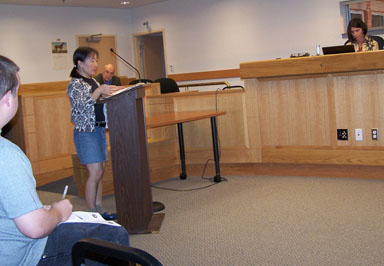
In Shik Lee presents for the Dryden Youth Commission.
I didn't hear much discussion of the county budget problems, which seem likely to damage youth programs in particular. Many residents expressed their concerns at last month's budget presentation, and the Journal reported that the draft 2011 budget eliminates "the Municipal Youth Development program, which distributes funds to municipalities to support afterschool youth programs, and the Learning Web Community and Career Apprenticeship program, which offers academic help and job training to youth." I'm guessing that the $35,269 the 2009 report mentions as having come from county youth services will shrink or disappear, and that it'll be up to the Town (which already supports these programs with $44,252) to figure something out. We'll see, I guess - I'd certainly like to be wrong that there are stormclouds ahead.
The board discussed a letter from the Village of Dryden asking for help in setting up a water district along North Road, as existing service there may disappear otherwise. It's a long story involving a 3-inch 1890 water main that serves 15 properties outside of the Village, which can't be replaced because New York State law means that the Village of Dryden can't operate outside of its boundaries. Apparently no one noticed that in 1890, but it's becoming a large problem now as the pipe fails.
Deputy Supervisor David Makar suggested that the Town Board meet with the Village Board about it, or devote some of their agenda meeting time to the issue, as "this is probably a more important thing to work on than zoning." Steve Stelick pointed out that test well drills in that area from 2004 produced only poor-quality water, and Jason Leifer pointed out that putting in a water district could affect zoning and its results. (A water district would require approval from the property owners, who haven't been enthusiastic in the past.)
The almost final steps toward the municipal Health Consortium Agreement raised some questions as well, with some long silences in the meeting. Town Attorney Mahlon Perkins had raised some questions about the contract, and those concerns seemed amplified by provisions that required unananimous consent of all participants to change the terms of the agreement. The State Insurance Department had made the consortium include representation from labor, and David Makar worried that unanimous agreement on changes to the agreement might get vetoed by the people receiving benefits rather than the municipalities providing them. After a few rounds of conversation, it became clear that changing the agreement required unanimous consent of the munipalities only - still maybe too high a bar, but a different question. In the end the authorization to sign the agreement passed unanimously.
Other notable things that came up included Jim Ray's successful challenge of the assessment on Hillside Acres in Varna, dropping it from about $3.8 million to $3.1 million, reducing the tax roll substantially. Also, New York State continues to be extremely slow in actually coming through with the money on the Purchase of Development Rights for the Stuttle farm, though it was approved a long time ago.
September 21, 2010
Catching up with the Journal
Travel and work have put me behind, so here's a quick catching up with the last few days of the Ithaca Journal. Little of it is specific to Dryden, but it's all relevant.
Dryden schools got dinged by the state, though student performance seems to be improving. State standards are just getting more demanding faster than improvement is happening.
The DEC released a state forest management plan that includes Yellow Barn and Hammond Hill State forests.
After a plane struck a deer July 25th, the FAA requested (and is largely funding) a wildlife assessment for Tompkins County Airport.
November's congressional race seems to be within eight points. (For more detail and poll internals, see this Times-Union piece.)
The Journal had a few more pieces on last week's EPA hydrofracking hearings, including a wrap-up, a report on the crowds, and note on the last speaker. For more on next steps, see this New York Times piece on likely advisors to the process.
The County Legislature is setting up a committee to look at expanding broadband access to the Internet, and it looks like back pay for the Sheriff's road patrol was arbitrated.
There's a piece on promoting the Finger Lakes Trail, which crosses through Dryden's southeast corner.
Finally, the state Public Service Commission approved a substantial rate increase for NYSEG. (What happened to NYSEG backing down? I guess they didn't.
September 23, 2010
Cortland Produce coming to Dryden?
I'd just noticed the disappearance of Ithaca Produce, but now it looks like that building may soon be in use for its intended purpose once again. Cortland Produce is considering moving to that distribution facility, if they can sort through Ithaca Produce's bankruptcy proceeding and get some tax abatements. There's a bit of an explanation of what happened to Ithaca Produce and why this should go differently:
Ithaca Produce based its expansion plans on its ability to get new business, particularly from Route 13 chain restaurants, but that didn't happen and they couldn't make the debt service payments, TCAD President Michael Stamm said. That shouldn't be a problem for Cortland Produce as the company primarily services local restaurants and has no outstanding debt, Tesoriero said.
There's also an update on the dire county budget, and I'll note this piece on local elections to note that there are no Town of Dryden positions on the ballot this year, for the first time since 2004.
Beyond the Journal, there are a few pieces on the Arcuri/Hanna congressional campaign. This one looks at television commercials, while this one looks at how national trends may or may not affect the outcome.
That's not me
If you're reading through the Ithaca Journal online and find comments from someone named "LivingInDryden", that's not me. I post there occasionally as simonstl.
Onondaga Land Claim case thrown out
I doubt it's anywhere near the end of the story, but the Onondaga Nation's land claim suit hit a big bump as it was thrown out of court. While I don't expect the suit, even if successful, to have a major impact, it does include a bit more than the eastern half of the Town of Dryden, roughly Etna and east.
You can find more on the suit in the land claim category of this site and at the Onondaga Nation's site.
"Non-partisan" ain't neutral
Regular readers of this blog are likely aware that I'm not a fan of Assemblywoman Barbara Lifton for many reasons. I've voted against her endorsement by the Tompkins County Democratic Committee, criticized her on a variety of issues, and been, well, less than polite at a few public forums. The last thing I really want to do with this blog is republish Lifton press releases.
Every now and then, though, something so infuriating comes up that the only right response is to republish a Lifton press release:
Lifton Campaign Challenges Opponent to Engage in Fair Debate, Reveal Actual Party and Anti-government Group Affiliations Publicly
The campaign of Assemblywoman Barbara Lifton has been approached by Ms. Kelly Kheel, who initially represented herself, on Sept. 8, as follows:
I am hosting a Meet the Candidate night in Tompkins County, NY. This is a non partisan forum. We plan to send invitation (sic) and moderate the event. The date is Sept. 25 at 7 pm. Mr. Reynolds has agreed.
Thank you for your consideration.
Cordially,
Kelly KheelThe Lifton campaign made repeated efforts to work with Ms. Kheel to agree to a time, format and location that would allow Assemblywoman Lifton's participation in a forum. Repeated requests for information about Ms. Kheel's "group" were responded to with minimal or misleading information. Eventually, the Lifton Campaign was able to discover, through on-line research, that Ms. Kheel's group is 912 TEA CTCNY. Reading the information on their website, at http://www.meetup.com/912Tea-Party-Patriots-Tompkins-County-NY/ , reveals that many of their 66 members reside outside of the Cortland/Tompkins area that they purportedly represent. Their current headline reads "We Surround Ithaca." The web page also reveals that Assemblywoman Lifton's opponent has been an active member of this group since April 14, 2010, although this information is not included on his campaign website, nor did Ms. Kheel mention that Mr. Reynolds was a member of her group in her correspondence with the Lifton campaign until we brought this fact up with her.
The Lifton Campaign challenges Mr. Reynolds to be open and above-board with the public about his true party affiliations. On the Tea Party group's website, his member page identifies him, in his own words, as a "Reagan republican Cheif Financial Officer," and he has also represented himself to the media as a Republican. Yet, while he is the Republican nominee for Assembly, his Board of Elections records identify him as a registered member of the Conservative Party. He has made public challenges to our campaign to engage in large numbers of debates, and then apparently encouraged the organizers of a group he is a member of to misrepresent itself as an impartial entity and set up a rigged "forum" in which the group leader acted as moderator.
Fair play and honest public discourse are the cornerstones of our democracy. The Lifton campaign challenges her opponent to engage in honest dicussion, in truly impartial forums, of the actual issues facing NYS government. We also challenge Mr. Reynolds to explain how he would uphold the Constitution of the State of NY if he accepts the 4th principle of Ms. Kheel's group: "The family is sacred. My spouse and I are the ultimate authority, not the government." Would he be willing to uphold NYS laws? Is his goal to become a NYS Assembly Member, or to spread the anti-government message of the TEA Party?
That's not an invitation to a debate - it's an invitation to an ambush. Dryden's had some contentious debates in the past, probably peaking in 2007 at Varna. I'll admit that I felt ambushed by some of the extremely right-wing questions, not to mention false claims - but at least the moderators of those events actually were neutral.
The first of the 2007 debates was moderated by the League of Women Voters, and the next two were moderated by WHCU host Geoff Dunn. Dunn makes a point of registering as a blank and of taking political signs only when he can signs from all sides - I don't know what his personal politics are, but he does an excellent job of keeping them out of the way when running a debate.
I worry that few undecided voters actually show up at debates, and there seems to be a regular battle to stack the audience with supporters. That said, stacking the moderator as well as the audience goes way way way outside of anything I'd recognize as decent politics.
If this is the kind of change the Tea Party folks want to bring to politics, we have some major problems before we even get to actual issues.
September 24, 2010
Dryden plays minor role in Ithaca police story
This morning's Ithaca Journal has a long article on Ithaca Police Office Jason Lansing's resignation after evidence grew of his using drugs and associating with convicted drug dealers. Dryden turns up in passage like:
Lansing told investigators he had abused hydrocodone -- which a Dryden doctor had prescribed for his injured knee -- to the point that he ran out of the drug, suffered withdrawal symptoms and had to miss work....
He began seeing the Dryden doctor after injuring his knee while arresting an intoxicated student, Lansing said. While wrestling the student to the ground, the student and his partner fell on his knee, he recalled....
The following Sunday they talk a few times while driving to meet each other somewhere on Route 13 near Ithaca.
"I passed the f___ing state police," Laganiere says as they're driving toward each other. "Alright well I just passed the pigs."
They met at the office of Lansing's Dryden doctor and took Laganiere's limo, driven by a Hispanic male, to Turning Stone Casino, according to Lansing's interview.
The "Dryden doctor" remains anonymous, and it sounds like some of why Lansing contacted Laganiere was because the doctor stuck to the limits on prescribing the drugs. The Ithaca story is also a Tompkins County story to some extent because Lansing's father, Ken Lansing, is running for sheriff. The Journal quotes Ken Lansing a bit as well:
Reached for comment on Thursday, Lansing called his drug-abuse problem a disease and said he's been sober for months. He didn't tell the department about it because he and his father decided to handle the problem "in the family," he explained....
Ken Lansing said he had no comment, other than to say that Jason resigned from the department for personal reasons. His son is 29 years old, and he has no right to speak for him, he added.
The story's drawn lots of comments, most of them seeming to question the timing of the article.
Varna Fire Company open house Sunday
The Varna Volunteer Fire Company will be having an open house this Sunday, September 26th from 2:00pm to 5:00pm at 14 Turkey Hill Road, just off Route 366. They'll be showing off their newly completed bunkhouse, among other projects.
September 25, 2010
Reward money doubled in Bangs case
The "reward for information leading to the arrest and conviction of anyone involved in the arson of Ithaca Police Sgt. Bryan Bangs' home now stands at $20,000," thanks to an anonymous donor.
The Journal also has a fairly vague report of a fire "in the vicinity of 92 West Main Street in Dryden." It doesn't sound like a house fire, but I guess we'll have to wait to find out. Update: the fire was at Stelick's Auto, in three trailers storing wood and equipment.
September 29, 2010
Does the state actually review these?
I'd noted back in January that the Town Board discussed some strange flaws in a gas-drilling approval on Irish Settlement Road. The state Department of Environmental Conservation didn't seem to have looked at the site very carefully. Now residents are pushing back on a DEC policy that lets drillers put "not known" all over their applications. The state fills those in, but based on the January discussion I'd say it's not exactly careful about it either.
This year's green house tour is this Saturday and Sunday from 10:00am to 4:00pm. You can find more details here. It looks like there are two houses in the Town of Dryden this year, one on German Cross Road and one on North Wood Road.Finally, I'm pretty sure Thomas Seeley, the author of this book on honeybee democracy, is a Dryden resident. It's not normally the way people think of honeybees, but the more I've learned about them the more complex their world seems to be.



